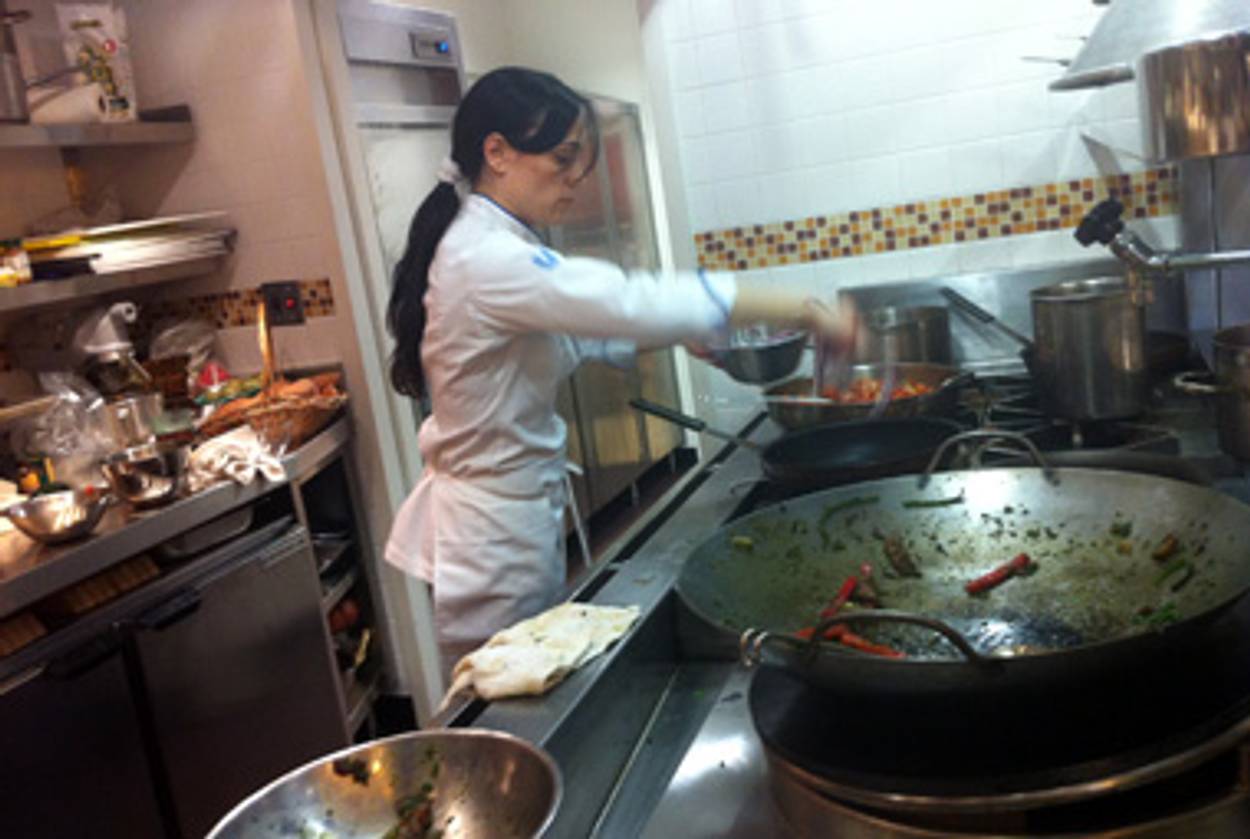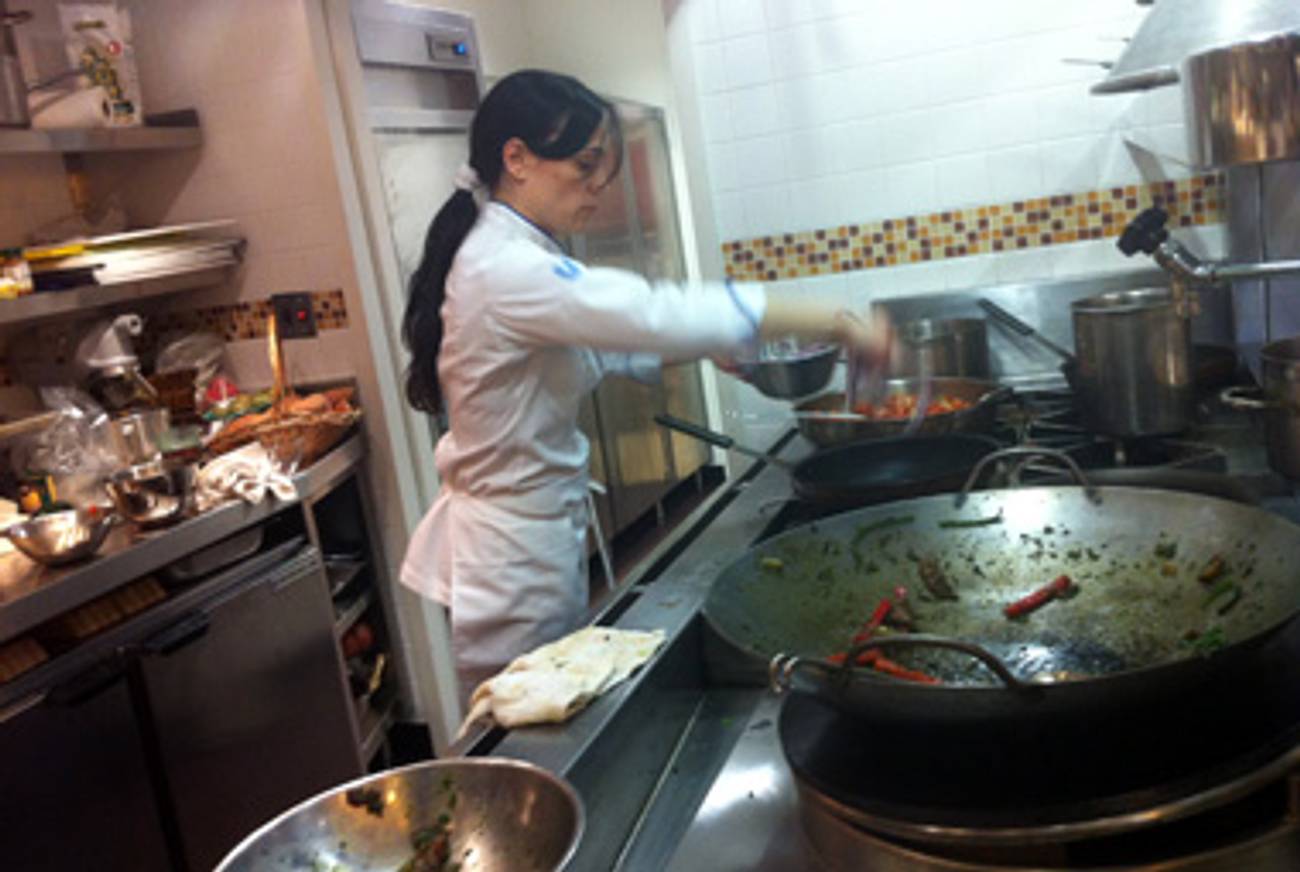World Feeder
Einav Gefen got her start at Tel Aviv’s toniest restaurants. As top chef at food giant Unilever, she now has a tougher task: developing frozen dinners that are true to her culinary roots.




Sheila from Des Moines loves frozen meat lasagna, the kind she can microwave in the plastic tray it comes in and serve to her ravenous, squirmy children within 15 minutes. She’s interested in trying lemon-herb shrimp, which sounds really fancy. She thinks goat cheese is weird, and she has never heard of saffron and does not want to start hearing about it now. She scrunches up her nose at the suggestion of chocolate-praline-bacon ice cream, but chocolate-pretzel ice cream … now, that might be tasty.
Sheila from Des Moines is the imaginary shopper who Einav Gefen thinks of while at work at Unilever North America, a branch of the global consumer-products titan that earned nearly $60 billion last year. Anyone who licks a cone of Ben & Jerry’s Chunky Monkey, eats a sandwich with Hellmann’s mayonnaise, sips a cup of Lipton tea, spreads Skippy on celery, slurps Slim-Fast shakes, or munches toast topped with Country Crock has Unilever to thank. Like God, or molecules, Unilever is everywhere.
Gefen is the company’s head corporate chef in the United States, and she develops new food products for its North American market. Unilever produces items on such a massive scale that it is said to buy, for instance, 3 percent of the world’s palm oil, 4 percent of its tomatoes, and 12 percent of its black tea. This requires a certain mindfulness; when Gefen and her team of chefs created a new raspberry-hazelnut vinaigrette for Wish-Bone, the company had to purchase the entire hazelnut crop of Washington state that year. When she wanted to add a little arugula to a frozen meal being created for Bertolli, a mid-range Italian brand, she learned that there was simply not enough time to alert growers about the sheer volume of arugula that would be required, so she had to give up the ingredient. In a project to reformulate Ragú pasta sauce with more vegetables, she had a moment of realization that her own tinkering in the kitchen involved “endless, endless fields of tomatoes in California,” she said. “To wrap my head around that was like … wow.”
Gefen, 39, is ropy and thin, with big brown eyes, a pointy chin, a sprinkling of freckles, and a girlish gap between her two front teeth. She has the vivacity and enthusiasm of a cheerleader along with Hebrew-accented English and Israeli matter-of-factness. (“Jennifer, lee-son to me.”)
Unilever’s North American headquarters, in Englewood Cliffs, N.J., spreads out over a sprawling campus of low-slung office buildings. Inside is a vast, fluorescent-lit warren of cubicles and boardrooms and glass display cases that show off the company’s products like pieces of art. Gefen’s fiefdom, the research kitchen, is an oasis of warmth and savory smells situated in the middle of this corporate expanse. It looks like a modern home kitchen multiplied by 20: a great sweep of black granite counters, custom wooden cabinets, stainless-steel sinks, luscious incandescent lighting, and multiple electric stoves, gas stoves, convection ovens, microwaves, toasters, and blenders.
On a brisk morning recently, she was flitting around Unilever’s research kitchen in chef whites and comfortable black shoes, overseeing preparations for a lunchtime presentation to members of the company’s frozen-foods team. Her team of chefs was dispersed around the room concocting the afternoon’s lunch presentation, about which I was sworn to secrecy. One chef pulsed a blender full of fresh herbs, another pulled trays of ice cream treats from a freezer, and another fired up four burners at a restaurant-caliber stove. They explained that they were working on a frozen-meal concept, inspired in part by the success of P.F. Chang’s Home Menu: Frozen Meals for 2, a line of frozen Chinese food that was introduced by the company last year. Gefen and her team had spent two years developing it. She had no expectation that the fruits of the current project would appear in stores any quicker.
“It’s like giving birth,” Gefen, a mother of three, told me. “For this, there’s no epidural.”
Growing up in Ramat Ilan near Tel Aviv, Gefen was interested in food from a young age. She watched her mother, Ruthie, channel her German roots through baking (“She loved measuring things exactly”) and her adopted Israeli self in cooking with fresh, seasonal food, largely because that’s all there was in Israel at the time. Imports were rare.
“You had tomatoes only in the summer and avocados only three weeks of the year, and God knows in those three weeks we ate enough avocados for a year,” Gefen said. “My mom would make very Israeli things. She took strawberries and bananas and mixed them with sour cream and sugar—that was my favorite. She used to grate tomatoes and mix them with a little cheese and salt, and I was in heaven.”
The family was secular, although like many secular Israelis, they lit candles and gathered for traditional Friday-night dinners featuring Ashkenazi staples.
“My uncle grated fresh horseradish, and my father’s aunt used to make gefilte fish. She had the carp in the bathtub and killed them herself,” Gefen said. “She made it with a lot of garlic, more savory than sweet. I love gefilte fish.”
Gefen’s father, Gershon, was a pilot for Arkia, Israel’s second-largest airline, and he often brought home treats from other countries—stinky cheeses, exotic mustards, strange spreads—that fascinated her. Eventually, Gefen tagged along with him to South Africa, England, Austria, and elsewhere. Her primary interest on these trips was to go to local supermarkets and observe what people bought.
After her army service, Gefen studied social behavior and communication in college, but the only behavior she wanted to research centered around food. She inserted herself in a hole-in-the-wall Ethiopian restaurant near Tel Aviv’s old bus station to watch injera bread being baked. She wrangled an introduction to her classmate’s Bukharian grandmother to observe what she and her neighbors did in their kitchens.
Instead of pursuing a medical or law degree as her father hoped, Gefen got an entry-level job assisting the head pastry chef at Orna and Ella, a popular bistro on Tel Aviv’s fashionable Shenkin Street. Upscale cuisine was blooming in Tel Aviv at the time. For years, serious Israeli foodies had to leave the country to experience fine dining. But by then, a cluster of top Israeli chefs who had worked abroad had brought their skills back to their native land. At Orna and Ella, Gefen learned to make classical French pastry and earned a reputation as a tireless worker and quick study. In 1995, she heard about an opening for a line cook at Mul Yam, one of Tel Aviv’s best restaurants, and she asked her boss to recommend her for the job. He phoned Mul Yam and said, “Look, we have this young woman here. She has no idea about cooking, but she can fold 50 egg whites into chocolate.” She became Mul Yam’s first female line cook, and eventually its sous chef.
Gefen came to New York in 1999 to attend culinary school, and her career progressed at a steady clip, including a stint at Daniel, the flagship restaurant of Daniel Boulud, and two years as the executive chef at Danal, a French restaurant near Union Square. By then, Gefen was a mother, and the grueling pace of restaurant life was taking its toll. To slow down, she became the director of the culinary center at the then-new Jewish Community Center of the Upper West Side, where she oversaw the design of the teaching kitchen and programmed culinary classes; part of her job involved explaining kosher compliance to guest chefs and walking them through their anxieties about it (“Their question was always, ‘What are eggs? Dairy or meat?’ ”) She then went to work as an instructor at her alma mater, the Institute of Culinary Education. In 2008 she heard that Unilever was hiring.
The most challenging part of her Unilever interview was an Iron Chef-style exercise, in which she was given 90 minutes to create three meals out of whatever she found in the research kitchen. She made chicken with sumac, olive oil, and garlic, marinated in beet juice and served over rice pilaf with raisins and almonds; flank steak smothered in mango barbecue sauce with curried potato chips; and a pomegranate tea-smoked pork loin with quick pickled cucumbers.
“I explained that the chicken and rice represents Israel, where I come from; the flank steak is America, where I am, and the pork smoked in pomegranate tea is my perception of food in the future, where I want to be,” Gefen said.
It can be perplexing to try and understand how a chef who knows full well the difference between sauce béchamel, sauce soubise, and sauce bordelaise can be satisfied making a frozen beef-and-broccoli dish that’s sold in a foil bag. Part of it seems to be the challenge of taking the artisanal trends emerging at restaurants in New York and Los Angeles and imagining how they might be adapted to play in Peoria.
Part of it also seems to be a kind of gastronomic pragmatism, an acceptance of how people actually cook and eat rather than how they’re told to. Unlike the Michael Pollans of the world, urging Americans to prepare meals from scratch with organic ingredients grown within 10 miles of their homes, Gefen is happy to meet them where they are, which more often than not is in the frozen-food aisle of the supermarket.
“Our ability to cook is diminishing. We’re reaching the point with new mothers where their own grandmothers didn’t cook anymore, so they didn’t have anyone to watch in the kitchen,” she said. “It’s great to feel you can contribute … making their lives easier and tastier so at the end of the day their kids say, ‘Yo, mom, awesome dinner!’ ”
As lunchtime rolled around, 10 members of the company’s frozen-foods team gathered at Unilever’s research kitchen to evaluate the super top-secret meal that Gefen’s unit had spent the morning preparing. They listened to a description of the food and watched a PowerPoint presentation about similar products offered by their competitors. They scrutinized the handsomely displayed dishes as if they were suspects in a police lineup. Then they dug in.
I cannot share the highly proprietary details of this lunch because I fear that the team would come after me with ice picks, not to mention lawsuits. But I can tell you that there were savory ———— stuffed with fragrant ———— and —————, braised ———— topped with ————, and a colorful platter of ——————— flecked with savory ———— and ———. In a couple of years, you may be able to walk into grocery store and buy these dishes for yourself. In the meantime, let me just say: They’re delicious.
Jennifer Bleyer is a New York-based journalist who has written recently for the New York Times, Slate, Cosmopolitan, City Pages, and TheAtlantic.com. She tweets at @jennypencil.
Jennifer Bleyer is a New York-based psychotherapist and writer.